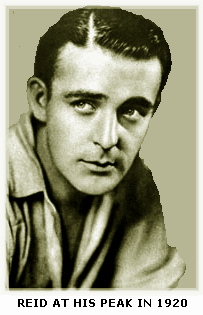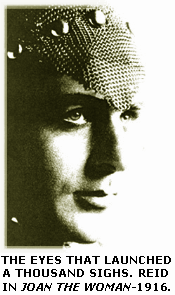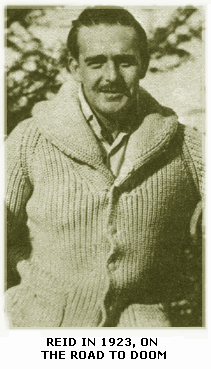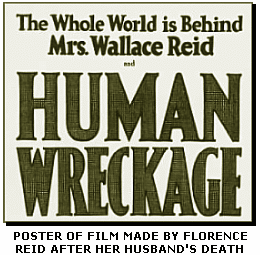"Nobody could do anything with Wally."
--FLORENCE REID
 The vast process of sweeping out the Hollywood stables suffered during 1922 because there was no way to hide the sad rum-and-morphine-wracked body of Wallace Reid. The immensely popular Wally-ex-artist, ex-writer, ex-jazz musician, ex-athlete, ex-very-big Box Office-was taking the cure as Hollywood's most dismal year came to a close. Will Hays didn't shed any tears over the pitiful, wasted 6- foot 3-inch hulk in the sanitarium. The film czar's Christmas message to the world outside the movie capital said that Reid "should be dealt with as a diseased person-not be censured, shunned." The star had in fact been shunned for the best part of two years before Hays' Yuletide greetings were issued. Indeed, the cure then in process may well have been for naught. Reid's name headed a roster of 117 persons deemed "unsafe" in a searching studio-sponsored shoo-fly survey into,the private lives of Hollywood's working stiffs, big and small.
The vast process of sweeping out the Hollywood stables suffered during 1922 because there was no way to hide the sad rum-and-morphine-wracked body of Wallace Reid. The immensely popular Wally-ex-artist, ex-writer, ex-jazz musician, ex-athlete, ex-very-big Box Office-was taking the cure as Hollywood's most dismal year came to a close. Will Hays didn't shed any tears over the pitiful, wasted 6- foot 3-inch hulk in the sanitarium. The film czar's Christmas message to the world outside the movie capital said that Reid "should be dealt with as a diseased person-not be censured, shunned." The star had in fact been shunned for the best part of two years before Hays' Yuletide greetings were issued. Indeed, the cure then in process may well have been for naught. Reid's name headed a roster of 117 persons deemed "unsafe" in a searching studio-sponsored shoo-fly survey into,the private lives of Hollywood's working stiffs, big and small. There was a story that when the blacklist was�shown to the producer who had Reid under contract, the man protested bitterly, saying:
There was a story that when the blacklist was�shown to the producer who had Reid under contract, the man protested bitterly, saying:
"You should know that you are asking the impossible. Why, it would mean at least a two-million-dollar loss to us to do a thing like this in the case of this one man . . . a thing like that would simply be suicide."
Wally Reid solved the problem nicely for Will Hays, if not for the men who hoped someday to straighten him out again at the box office. He died on January 18, 1923, a victim of narcotics, and his passing came as something of a shot in the arm to another section of Hays' year-end pronouncement: "We are traveling the highway to better things in filmdom . . . soon there will be a model Hollywood . . . I have faith that unfortunate incidents will be things safely of the past . . . "
 Reid's wife Florence, who had appeared in movies as Dorothy Davenport, blamed the tragedy on the wild life cited by Elinor Glyn in her dissection of the film colony. Mrs. Reid said the downfall started in 1920 when Reid went to New York to do Forever. She said he was hit on the head with a rock during the shooting and never seemed to be the same again. "Gradually, he got to drinking with his Bohemian friends," she went on, "and soon this wasn't a home. It was a roadhouse. Wally's friends would come in here by the scores, at any odd hour of the day or night. They came, they stayed, they drank. It was one wild party after another, each one worse than the last. Nobody could do anything with Wally. And then-morphine."
Reid's wife Florence, who had appeared in movies as Dorothy Davenport, blamed the tragedy on the wild life cited by Elinor Glyn in her dissection of the film colony. Mrs. Reid said the downfall started in 1920 when Reid went to New York to do Forever. She said he was hit on the head with a rock during the shooting and never seemed to be the same again. "Gradually, he got to drinking with his Bohemian friends," she went on, "and soon this wasn't a home. It was a roadhouse. Wally's friends would come in here by the scores, at any odd hour of the day or night. They came, they stayed, they drank. It was one wild party after another, each one worse than the last. Nobody could do anything with Wally. And then-morphine."
 It was said that Reid suffered from insomnia and exhaustion as well as bootleg whiskey during the making of Forever--one of his best pictures--and had taken to morphine to shore up his energy so that he could go before the klieg lights day after day. The dread narcotic hooked the actor. Mrs. Reid laid his death to the unspeakable misery he suffered trying to break the habit. When the pathetic struggle was over, Mary Pickford uttered the kindest epitaph for Reid.
It was said that Reid suffered from insomnia and exhaustion as well as bootleg whiskey during the making of Forever--one of his best pictures--and had taken to morphine to shore up his energy so that he could go before the klieg lights day after day. The dread narcotic hooked the actor. Mrs. Reid laid his death to the unspeakable misery he suffered trying to break the habit. When the pathetic struggle was over, Mary Pickford uttered the kindest epitaph for Reid.
"His death is a very great tragedy," she said. "I know he would have lived down every mistake he made."
The Hays Office had no comment. The guardian of movie decency was too busy pre-digesting the product in the cans and making sure everything had a happy ending, preferably with a strong moral message. The producers, for their part, found that Hays' pious pronouncements didn't
 preclude a little passion on celluloid. Even while the nice-nelly talk was flowing forth, as Frederick Lewis Allen observed, there were movie ads heralding such items as "beautiful jazz babies, champagne baths, midnight revels, petting parties in the purple dawn" and "neckers, petters, white kisses, red kisses, pleasure-mad daughters, sensation-craving mothers . . . the truth-bold, naked, sensational." The pictures weren't quite as vivid as the ads said, of course, but neither were they ideal for Sunday evening socials, even with their happy endings. Hays undoubtedly knew it. He was a shrewd fellow. He kept the enemy at bay without driving the customers away.
preclude a little passion on celluloid. Even while the nice-nelly talk was flowing forth, as Frederick Lewis Allen observed, there were movie ads heralding such items as "beautiful jazz babies, champagne baths, midnight revels, petting parties in the purple dawn" and "neckers, petters, white kisses, red kisses, pleasure-mad daughters, sensation-craving mothers . . . the truth-bold, naked, sensational." The pictures weren't quite as vivid as the ads said, of course, but neither were they ideal for Sunday evening socials, even with their happy endings. Hays undoubtedly knew it. He was a shrewd fellow. He kept the enemy at bay without driving the customers away.



 The vast process of sweeping out the Hollywood stables suffered during 1922 because there was no way to hide the sad rum-and-morphine-wracked body of Wallace Reid. The immensely popular Wally-ex-artist, ex-writer, ex-jazz musician, ex-athlete, ex-very-big Box Office-was taking the cure as Hollywood's most dismal year came to a close. Will Hays didn't shed any tears over the pitiful, wasted 6- foot 3-inch hulk in the sanitarium. The film czar's Christmas message to the world outside the movie capital said that Reid "should be dealt with as a diseased person-not be censured, shunned." The star had in fact been shunned for the best part of two years before Hays' Yuletide greetings were issued. Indeed, the cure then in process may well have been for naught. Reid's name headed a roster of 117 persons deemed "unsafe" in a searching studio-sponsored shoo-fly survey into,the private lives of Hollywood's working stiffs, big and small.
The vast process of sweeping out the Hollywood stables suffered during 1922 because there was no way to hide the sad rum-and-morphine-wracked body of Wallace Reid. The immensely popular Wally-ex-artist, ex-writer, ex-jazz musician, ex-athlete, ex-very-big Box Office-was taking the cure as Hollywood's most dismal year came to a close. Will Hays didn't shed any tears over the pitiful, wasted 6- foot 3-inch hulk in the sanitarium. The film czar's Christmas message to the world outside the movie capital said that Reid "should be dealt with as a diseased person-not be censured, shunned." The star had in fact been shunned for the best part of two years before Hays' Yuletide greetings were issued. Indeed, the cure then in process may well have been for naught. Reid's name headed a roster of 117 persons deemed "unsafe" in a searching studio-sponsored shoo-fly survey into,the private lives of Hollywood's working stiffs, big and small. There was a story that when the blacklist was�shown to the producer who had Reid under contract, the man protested bitterly, saying:
There was a story that when the blacklist was�shown to the producer who had Reid under contract, the man protested bitterly, saying: Reid's wife Florence, who had appeared in movies as Dorothy Davenport, blamed the tragedy on the wild life cited by Elinor Glyn in her dissection of the film colony. Mrs. Reid said the downfall started in 1920 when Reid went to New York to do Forever. She said he was hit on the head with a rock during the shooting and never seemed to be the same again. "Gradually, he got to drinking with his Bohemian friends," she went on, "and soon this wasn't a home. It was a roadhouse. Wally's friends would come in here by the scores, at any odd hour of the day or night. They came, they stayed, they drank. It was one wild party after another, each one worse than the last. Nobody could do anything with Wally. And then-morphine."
Reid's wife Florence, who had appeared in movies as Dorothy Davenport, blamed the tragedy on the wild life cited by Elinor Glyn in her dissection of the film colony. Mrs. Reid said the downfall started in 1920 when Reid went to New York to do Forever. She said he was hit on the head with a rock during the shooting and never seemed to be the same again. "Gradually, he got to drinking with his Bohemian friends," she went on, "and soon this wasn't a home. It was a roadhouse. Wally's friends would come in here by the scores, at any odd hour of the day or night. They came, they stayed, they drank. It was one wild party after another, each one worse than the last. Nobody could do anything with Wally. And then-morphine." It was said that Reid suffered from insomnia and exhaustion as well as bootleg whiskey during the making of Forever--one of his best pictures--and had taken to morphine to shore up his energy so that he could go before the klieg lights day after day. The dread narcotic hooked the actor. Mrs. Reid laid his death to the unspeakable misery he suffered trying to break the habit. When the pathetic struggle was over, Mary Pickford uttered the kindest epitaph for Reid.
It was said that Reid suffered from insomnia and exhaustion as well as bootleg whiskey during the making of Forever--one of his best pictures--and had taken to morphine to shore up his energy so that he could go before the klieg lights day after day. The dread narcotic hooked the actor. Mrs. Reid laid his death to the unspeakable misery he suffered trying to break the habit. When the pathetic struggle was over, Mary Pickford uttered the kindest epitaph for Reid. preclude a little passion on celluloid. Even while the nice-nelly talk was flowing forth, as Frederick Lewis Allen observed, there were movie ads heralding such items as "beautiful jazz babies, champagne baths, midnight revels, petting parties in the purple dawn" and "neckers, petters, white kisses, red kisses, pleasure-mad daughters, sensation-craving mothers . . . the truth-bold, naked, sensational." The pictures weren't quite as vivid as the ads said, of course, but neither were they ideal for Sunday evening socials, even with their happy endings. Hays undoubtedly knew it. He was a shrewd fellow. He kept the enemy at bay without driving the customers away.
preclude a little passion on celluloid. Even while the nice-nelly talk was flowing forth, as Frederick Lewis Allen observed, there were movie ads heralding such items as "beautiful jazz babies, champagne baths, midnight revels, petting parties in the purple dawn" and "neckers, petters, white kisses, red kisses, pleasure-mad daughters, sensation-craving mothers . . . the truth-bold, naked, sensational." The pictures weren't quite as vivid as the ads said, of course, but neither were they ideal for Sunday evening socials, even with their happy endings. Hays undoubtedly knew it. He was a shrewd fellow. He kept the enemy at bay without driving the customers away.